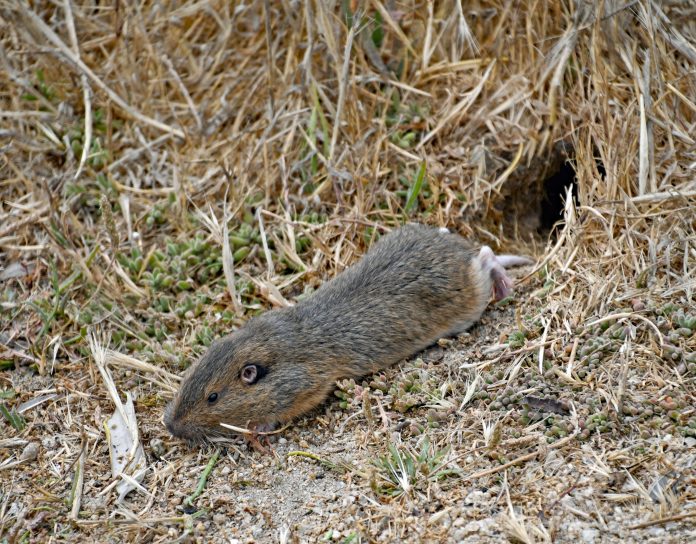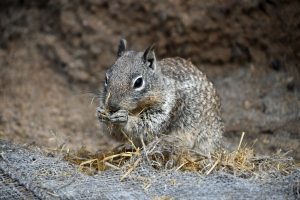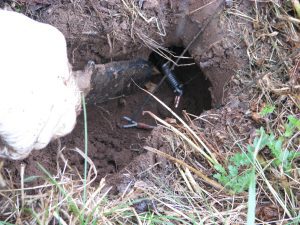
As part of a regular 15-year pesticide review, the U.S. Environmental Protection Agency has proposed several measures that could significantly affect how growers can apply rodenticides. At the same time, costs associated with using the remaining products will likely increase with the additional proposed application requirements, said Roger Baldwin, UCCE human-wildlife conflict specialist.
“There will be pretty substantial restrictions on broadcast and spot treatments,” he said. “I’m not sure [growers] used those that much for ground squirrels. Bait stations will still be allowed for ground squirrels, but they’re going to eliminate use of anticoagulants more or less for gopher control.”
Included in the EPA’s proposal are requiring carcass surveys after application, prohibiting rodenticide use in habitat frequented by endangered species and requiring APF10 respirators and chemical-resistant gloves for applications.
Other Restrictions
A handful of other rodent control methods, including carbon monoxide injected into burrows and burrow fumigants, are not part of the EPA’s interim proposal.
Andrew and Ryan Vieira, who operate Vieira Farm Services in Turlock, offer rodent control using carbon monoxide as part of their custom application business. The two became interested in rodent control when they were in college looking for a side job, and carbon monoxide had a good worker safety profile if used correctly, they said.
“Now we have guys interested in [our rodent services] because it’s less hassle for them,” said Andrew Vieira, who’s also a PCA for Helena Agri-Enterprises.
The first application typically knocks down the rodent population, and a follow-up treatment lowers numbers even further, he said.
“Some people have us do it on a monthly or bi-monthly plan,” Ryan Vieira said. “In our area, gophers are active year-round. Ground squirrels will pick up more once it gets warmer.”
But even carbon monoxide pest control devices have fallen under increased regulation.
In October 2022, the newly adopted Section 6695 of Title 3 — California Code of Regulations limits use of these devices to businesses that perform pest control for hire. It also prohibits their use inside buildings or barns and sets buffers around buildings where the devices can’t be used. In addition, the devices, which must bear a U.S. EPA establishment number, can only be used for burrowing rodent control.
The EPA also revised a rule in 2017 that prompted the California Department of Pesticide Regulation to change its pesticide applicator certification program. Current holders of private applicator certificates will have to retest when their licenses come due and will not be able to renew by completing the appropriate continuing education classes.
The new private applicator exam offers a burrowing vertebrate pest fumigation certificate option. The retesting requirement is being phased in between 2024 and 2026 based on last names.

Potential Loss of IPM Tools
For nut producers, ground squirrels, pocket gophers and meadow voles (also called meadow mice) are the main burrowing rodent pests. Rodenticides, which involve chemically treated bait, are part of an overall integrated pest management program for rodents that also includes trapping and habitat modification, Baldwin said.
“Rodenticides knock populations down, and then you use other tools like trapping to keep them at a low population,” he said. The success of alternate rodent control also varies with species.
Gophers, for example, are fairly easy to trap, and this method often pencils out, Baldwin said. Managing ground squirrels, on the other hand, may be more difficult without rodenticides. Fumigation followed by trapping could be one alternative, but success varies depending on the squirrel population and soil type. The best time to fumigate is when the burrows are active and the soil is moist.
“It could definitely be more expensive to try to manage ground squirrels without rodenticides,” he said. “You could use a combination of fumigation and trapping, but the question is how much is that going to cost?”
Voles are more of a spotty rodent pest and aren’t as ubiquitous as gophers or ground squirrels in nut orchards, Baldwin said. Although costly, exclusion methods around tree trunks help prevent voles from girdling young trees.
Habitat modification, which includes keeping about a 3-foot radius around tree trunks free of vegetation and keeping cover crops mowed low to the ground, tends to make orchards less attractive to voles.
“But when vole populations explode, that wouldn’t be enough to keep them under control,” he said. That’s when growers turn to rodenticides since trapping voles isn’t usually successful.

EPA’s Proposal in a Nutshell
The EPA published the proposed interim decisions, as the proposed rodenticide rule changes are known, in the Federal Register in November 2022 with a 75-day comment period that ended February 13.
Baldwin said he didn’t expect the EPA to extend the comment period, based on what he’s heard from outside sources. But he said those with concerns could still voice them to their congressional representatives.
The proposals’ exact impacts on producers also will depend on how the agency writes the final rules once they review and respond to public comments, Baldwin said.
The proposed changes cover all 11 currently registered rodenticides. There are three first-generation anticoagulants: chlorophacinone, diphacinone and warfarin. It also includes four second-generation anticoagulants: brodifacoum, bromadiolone, difethialone and difenacoum. In addition, it covers four non-anticoagulants: zinc phophide, strychnine, bromethalin and cholecalciferol.
Of these, only first-generation anticoagulants, zinc phosphide and strychnine, are labeled for use against field rodents, such as ground squirrels, pocket gophers, voles, rats and mice, found in agricultural fields. But not all the active ingredients are labeled for all rodent species.
The EPA proposed making all 11 rodenticides restricted-use products, requiring prior training and certification before application. Because most already are considered restricted use against field rodents by CDPR, Baldwin said he expected to see few changes on that front.
“In California, most had already been restricted use,” he said. “For other states that didn’t have any state restricted use, that might change how they manage these products moving forward.”
Under the proposal, rodenticide labels also will require use of APF10 respirators and chemical-resistant gloves by applicators. This is a substantial change for some rodenticide labels and will require applicator fit testing.
Ultimately, the respirator requirement will make rodenticide applications more physically challenging, Baldwin said.
For the rodenticides used against field rodents remaining on the market, the EPA plans to require carcass surveys beginning on the third or fourth day after application, depending on the product. Should users find a carcass, they would have to collect it and dispose of it properly to prevent further exposure to non-target animals. In addition, they would have to report any non-target mortality to the EPA. Users also would have to continue the surveys every day or two days for at least two weeks after the last rodenticide application.
“Obviously, that’s costly and very time consuming,” Baldwin said.
In announcing the rule making, the EPA said the changes were needed to protect mammals, birds and, in particular, endangered and threatened species that may accidentally consume rodenticides and are killed. These are known as primary consumers. The EPA said it’s also concerned about secondary consumers, or animals that consume rodents that have eaten rodenticides.
Initially, the EPA based the proposed rules to include protection measures for three endangered species: Stephens’ kangaroo rats and Attwater’s prairie chickens, considered primary consumers, and the California condor, a secondary consumer.
Of those, Baldwin said the Stephens’ kangaroo rat could potentially have the greatest impact on the state’s nut producers. In areas designated as habitat, the only types of rodenticide applications allowed would be bait stations equipped with devices to exclude kangaroo rats.
But the three species are only the start; the EPA has said it plans to expand mitigation measures to cover about 90 other species listed under the Endangered Species Act.
“When you combine all of these species together, you’re going to get a pretty large chunk of the Central Valley that will have pretty substantial restrictions beyond what’s already limited,” Baldwin said.










